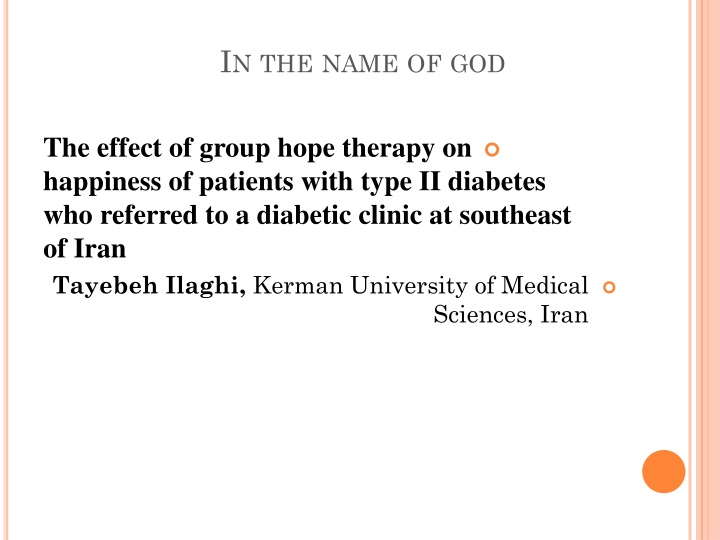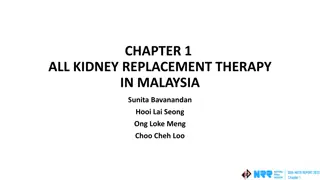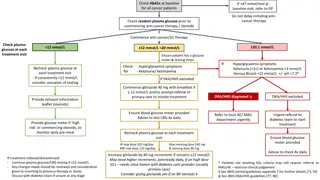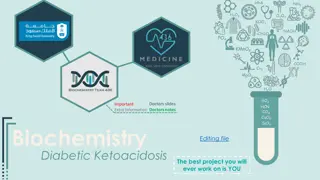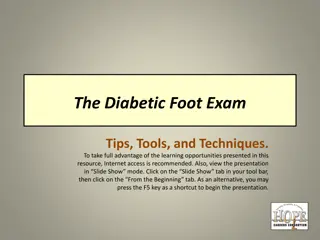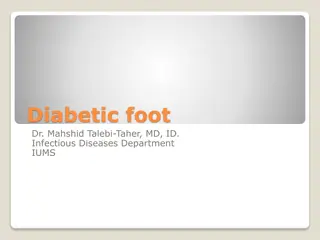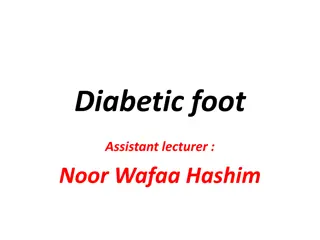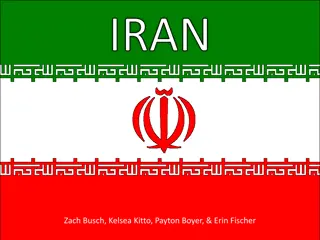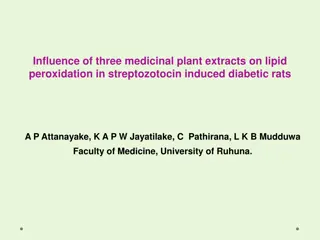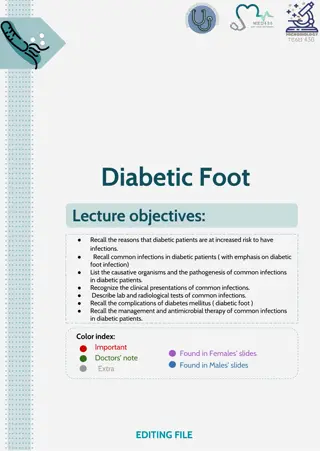Impact of Group Hope Therapy on Happiness in Type II Diabetic Patients: A Study in Southeast Iran
Diabetes poses significant health challenges globally, with increasing prevalence in Iran. This research investigates the effectiveness of group hope therapy in enhancing the happiness levels of patients with type II diabetes in a clinic in southeast Iran. Hope therapy, a coping strategy for incurable diseases, is highlighted as a positive intervention for behavioral empowerment. The study aims to contribute valuable insights into non-medicinal approaches to improving the well-being of diabetic patients.
Download Presentation

Please find below an Image/Link to download the presentation.
The content on the website is provided AS IS for your information and personal use only. It may not be sold, licensed, or shared on other websites without obtaining consent from the author.If you encounter any issues during the download, it is possible that the publisher has removed the file from their server.
You are allowed to download the files provided on this website for personal or commercial use, subject to the condition that they are used lawfully. All files are the property of their respective owners.
The content on the website is provided AS IS for your information and personal use only. It may not be sold, licensed, or shared on other websites without obtaining consent from the author.
E N D
Presentation Transcript
IN THE NAME OF GOD The effect of group hope therapy on happiness of patients with type II diabetes who referred to a diabetic clinic at southeast of Iran Tayebeh Ilaghi, Kerman University of Medical Sciences, Iran
Diabetes is a chronic metabolic disease and one of health problems especially in developing countries (1). Generally, it has been reported that over 285 million patients were affected by diabetes in 2010 throughout the world
predicted that the number of diabetic patients will increase up to 350 million individuals in 2020 and they will be over 438 million in 2030 (2). It has been reported that prevalence of diabetes is 24% in individuals over 40 years old in Iran. In addition, the number of individuals with such disease is increasing by 0.4% after age 40 per year (3).
Diabetes is the most cause of amputation, blindness, chronic failure of kidney and it is one of risk factors of cardiac diseases (3). Researches indicated that socio- mental problems, irritability, anger, depression and anxiety in diabetic patients are higher than normal individuals (4).
Happiness is a personally pleasant state that results from positive emotions. Happiness is the product of individual s positive judgment from life.(5). There are many non-medicinal methods to help happiness and adaptation of patients with diabetes. One of such methods is hope therapy. Hope is one of the most basic concepts in positive psychology(4).
Hope is considered as one of coping strategies for adaptation with incurable diseases (6). Namdari et al (2012) indicated that hope therapy was an effective intervention to correct and improve behavioural empowerments (7).
the present research aims to study the effect of group hope therapy on happiness of type II diabetic patients who referred to a diabetic clinic at southeast of Iran.
Methods and materials This is a quasi-experimental study conducted on two groups: intervention and control. The research was conducted in a diabetic clinic affiliated to medical science university of Sirjan at southeast of Iran. The research lasted from October to March 2015. Statistical population includes all patients with type II diabetes who had medical records and referred to clinic for care and treatment.
Inclusion criteria were willingness to participation, patients who were affected by type II diabetes based on medical record and were able to participate in group therapy sessions
Exclusion criteria were participation in psychological sessions at the same time, consumption of psychiatric medications, acute depression and recent death of one of close relatives.
Sample size was determined based on the study of Ghasemali et al (8) using following formula with 95% confidence and 90% power. Therefore 15 individuals were placed in each group. The number of each group was increased up to 20 individuals due to probability of dropout.
<0/05 d=12/25 1- =90%
happiness of all 400 patients that have been admitted to this center was assessed. Among 80 individuals who obtained mean score below 40, 40 individuals participated in the study by convenience sampling. After taking informed consent, they were allocated into intervention and control groups (20 individuals in each group) by using random table.
Data were collected by a two-part questionnaire. The first part includes demographic questionnaire such as gender, age, marital status and education level. The second part was Oxford happiness questionnaire (OHQ).
This questionnaire contains 29 items scoring between 0- 87. Therefore, the highest score is 87 suggesting the highest happiness and the lowest score is zero suggesting dissatisfaction of subjects with life and their depression. The validity of this questionnaire was confirmed by Noorbala et al in Iran.
They also reported the reliability of questionnaire as 92% via splitting method (9).hope therapy sessions were designed and implemented within 8 sessions for 90 minutes. Hope therapy was conducted weekly for two sessions.
Sessions were held as follows: Session 1: structure of sessions, educational goals and hope based on Snyder theory were introduced.
Session 2: exploration of hope growth, necessity of its presence and effect on wellbeing were discussed. A therapeutic relationship was made with participants and dynamic process of intervention group was considered.
Session 3: participants were asked to define their life stories Session 4: organizing stories based of three main components of Snyder s hope theory including goal, agent and pathways. In addition, it was tried to identify hopes in lives of participants and past achievements were considered to identify agent and pathways.
Session 5: participants were asked to provide a list of current events and important dimensions of life and to determine their importance. Session 6: expressing appropriate goals based on Snyder s theory and encouraging them to determine goals in each aspect of life
Session 7: expressing features of appropriate pathways and finding proper strategies for reaching determined goals Session 8: expressing strategies for protecting agent (for example, participants were asked to do their best for reaching goals via mental practice)
Hope therapy sessions were held by the researcher who passed practically such sessions under control of master of psychology. Routine educations of clinic were presented for control group and no intervention was done.
After intervention, both groups recompleted the questionnaire. Data were analyzed by SPSS version 21 using statistical methods such as inferential and descriptive statistics. Mean and standard deviation were used from descriptive statistics and independent T and paired T tests were used from inferential statistics.
Ethical considerations We get the ethical code with this number 1395.IR.KMU.REC and Participants were ensured that they could participate in the research voluntarily, their information was confidential, they could withdraw the study whenever they want and they would be informed about research results.
Results Results obtained by both groups showed that there was no significant difference between groups regarding demographic variables (P> 0.05). Mean age of individuals in intervention group was 46.35 10.17 and mean age of individuals in control group was 49.10 9.05. The number of women was higher than men (60%).
The mean score of happiness after intervention was 63.222.7 and 42.10 23.6 in intervention and control groups respectively. Results of T test suggested that a significant difference was found between intervention and control groups regarding happiness (P < 0.001). Mean happiness in control group was increased after the study but such difference was not significant (P = 0.22 (table 2).
Discussion and conclusion Results indicated that group hope therapy can be effective on happiness of type II diabetic patients in intervention group. The reason may be that hope is a strongly adaptive mechanism among patients with chronic diseases such as diabetic patients such that hopeful individuals can tolerate the disease more easily (10).
Research of Azizi et al (2016) in Kermanshah showed that hope therapy was effective on increase of happiness in elderlies (11). Results of the study conducted by Sharifi et al (2015) in Isfahan showed that group education based on Snyder s hope theory led to increase of happiness in elderlies (12).
hope can play important role in adaptation and mental health of diabetic patients. Most psychological problems of patients with diabetes are diet, limitation of activity, invasive monitoring of blood sugar, daily injection of insulin, physically chronic complications, hospitalization, and short lifetime. Mental disorders have been seen in one fourth of inpatients in medical wards and they are more prevalent in diabetic patients than public.
However, unfortunately they are remained non-diagnostically (13). It can be said that hope therapy was very helpful to facilitate adaptation, health and prevention from adverse effects of mental pressure. This method helps individual grow his/her abilities, information, orientations and hope for healthy life leading to increase of happiness. hope therapy will help such patients to cope with this disease (4).
Conclusion Generally, the most important result of the present research has been the effect of hope therapy on happiness. Happiness of patients with type II diabetes was more favorable by intervention of hope group therapy.
Authorities and therapeutic centers should require applying effectively positive strategies, increase of life expectancy and happiness in such patients. Therefore, it is suggested that short- and long-term follow ups should be used in further researches to study permanent effect of hope therapy education.
Since it is possible that effects of therapy are not continuous after one month and posttest, therefore, it is suggested that supportive sessions are held after completion of hope therapy sessions to maintain therapeutic effects in long term. Another limitation of present study is that sessions were controlled and held by the researcher.
Acknowledgment The paper was derived from M.S thesis in medical science university of Kerman with ethical code No. IR.KMU.REC.1395.6. thereby, I would thank to authorities, personnel and patients of diabetic clinic who helped me in the research.
Percent Frequency P value Gender Intervention group Female 60 12 0.18 Male 40 8 Total 100 20 Control group Female 65 13 Table 1: demographic features of participants Male 35 7 Total 100 20 Marital status Intervention group Married 11 55 0.65 Single 9 45 Total 20 100 Control group Married 11 55 Single 9 45 Total 20 100 Education Intervention group Primary 5 25 0.26 Elementary 3 15 Diploma 7 35 University 5 25 Total 20 100 Control group Primary 8 40 Elementary 2 10 Diploma 6 30 University 4 20 Total 20 100 Job Intervention group Self-employed 4 20 0.21 Employee 5 25 Housekeeper 7 35 Unemployed 0 0 Others 4 20 Total 20 100 Control group Self-employed 3 15 Employee 3 15 Housekeeper 10 50 Unemployed 2 10 Others 2 10 Total 20 100
Table 2: results of T paired tests for mean happiness before and after intervention in both groups Mean Standard deviation T Significance level Interventi Before 52.6 18.24 - 5.46 P < 0.001 on intervention After 63.2 22.7 intervention Control Before 40.05 11.7 - 0.90 P<0.22 intervention After 42.10 23.6 intervention
REFERENCES 1. Wild S, Roglic G, Green A, Sicree R, King H. Global prevalence of diabetes estimates for the year 2000 and projections for 2004;27(5):1047-53. 2. Tsai Y-W, Kann N-H, Tung T-H, Chao Y-J, Lin C-J, Chang K-C, et al. Impact of subjective sleep quality on glycemic control in type 2 diabetes mellitus. Family practice. 2012;29(1):30-5. 3. Haghdoost A, Rezazadeh-Kermani M, Sadghirad B, Baradaran H. Prevalence of type 2 diabetes in the Islamic Republic of Iran: systematic review and meta-analysis. East Mediterr Health J. 2009;15(3):591-9. 2030. Diabetes care.
4. Ghazavi Z, Khaledi-Sardashti F, Kajbaf MB, Esmaielzadeh M. Effect of hope therapy on the hope of diabetic patients. Iranian journal of nursing and midwifery research. 2015;20(1):75. 5. Hills P, Argyle M. Happiness, introversion extraversion and happy introverts. Personality and individual Differences. 2001;30(4):595-608. 6. Myers JE, Harper MC. practices with older adults. Journal of Counseling and Development: JCD. 2004;82(2):207. 7. Namdari K, Molavi H, Malekpoor M, Kalantary M. The effect of hope enhancing training on behavioral strengths in dysthymic patients. Journal of Shahrekord University of Medical Sciences. 2011;13(2):52-60. Evidence-based effective
8. ghasemali K, Naser S. Effect of shem therapy happiness and mental health in patients with type II diabetes journal of nursing diabet 2014 3(1):6-13. 9. Alipour A, Agah Heris M. Reliability and validity of the Oxford Happiness Inventory among Iranians. Journal of Iranian Psychologists. 2007;3(12):287-98. 10. Baljani E, Kazemi M, Amanpour E, Tizfahm T. Asurvey on relationship between religion, spiritual wellbeing, hope and quality of life in patients with cancer. Evidence Based Care. 2011;1(1):51-62. 11Female Students Who Referred to Isfahan Universit. Azizi M, Azizi A, Abedi A, Kajbaf MB, Fallahzadeh RA. The Effect of Spiritual Therapy on Hope of Life in y Counseling Center. Psychology. 2016;7(1):126. on
12. Sharifi M, Movallali G, Younesi S-J, Rostami M, Biglarian A. The effectiveness of mental rehabilitation based on hope intervention on increasing hope of students with physical-motor disabilities. J Soc Sci. 2015;1(4):1-7. 13. Das-Munshi J, Stewart R, Ismail K, Bebbington PE, Jenkins R, Prince MJ. Diabetes, common mental disorders, and disability: findings from the UK National Psychiatric Morbidity Survey. Psychosomatic Medicine. 2007;69(6):543-50.
